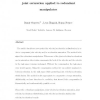Free Online Productivity Tools
i2Speak
i2Symbol
i2OCR
iTex2Img
iWeb2Print
iWeb2Shot
i2Type
iPdf2Split
iPdf2Merge
i2Bopomofo
i2Arabic
i2Style
i2Image
i2PDF
iLatex2Rtf
Sci2ools
RAS
2007
2007
Compensation of velocity and/or acceleration joint saturation applied to redundant manipulator
The article describes a new method for velocity/acceleration redistribution in order to compensate joint velocity and/or acceleration saturation. The method is designed for redundant manipulators. When some of the joint velocities/accelerations are in saturation other joints compensate the lack of the velocity and the velocity in the task space remains unchanged. Without the compensation the task space error would appear. Using the compensation method we can achieve maximal velocity/acceleration in the task space while preserving joint velocity/acceleration within limits. The method is also appropriate to compensate a torque saturation. Additionally, we have introduced a condition, that shows if the compensation is kinematically and mathematically possible or not. Key words: redundant manipulator, joint velocity/acceleration saturation, joint velocity/acceleration redistribution, joint velocity/acceleration limits, joint velocity/acceleration bounds Preprint submitted to Elsevier Scie...
Joint | RAS 2007 | Task Space | Velocity |
| Added | 27 Dec 2010 |
| Updated | 27 Dec 2010 |
| Type | Journal |
| Year | 2007 |
| Where | RAS |
| Authors | Damir Omrcen, Leon Zlajpah, Bojan Nemec |
Comments (0)

